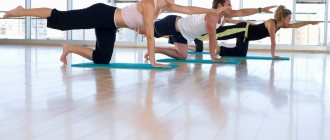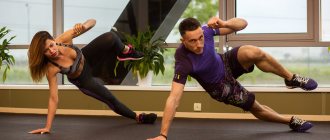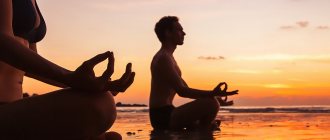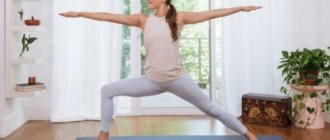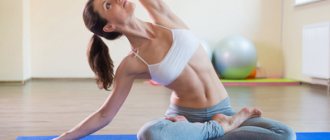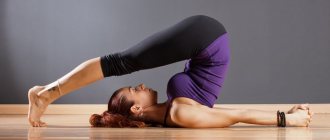Hatha yoga: where to start
Before moving directly to the practice itself, it is necessary to at least briefly familiarize yourself with the theory of hatha yoga and its basic principles. Hatha yoga views a person as a special energy structure, represented by 13 main channels that fill completely different types of energy.
Hence the goal of this type of yoga is to manage your energy and, accordingly, to improve your life qualitatively. The main components of classical hatha yoga:
- asana – a special position of the body;
- pranayama – a set of breathing exercises;
- meditation practice.
For a beginner yoga practitioner, it is very important to understand that yoga is not just a system of physical exercises, hatha yoga is a combination of the physical and spiritual, which allows you to qualitatively change your physical and mental health, and life in general.
Having carefully studied the description of hatha yoga in theory, do not rush to move on to practice; it is better to familiarize yourself in more detail with contraindications for classes, recommendations for daily routine and nutrition. And only then can you move on to the next stage of preparation - choosing the right place for yoga in your own apartment, if classes in the studio for some reason are not suitable for you.
For those who have decided to master the yoga technique for the first time, it is important to understand the dangers of the practice, in the event that, out of ignorance, the body is not properly prepared for asanas, or health indications are not taken into account. For this reason, it is recommended to take the first few classes with an instructor who will select an individual yoga program.
Subsequence
Eight consecutive blocks have been developed for the correct construction of a complex of asanas:
- warm-up;
- Surya Namaskar (sun salutation), for those who do not have proper physical training or are just getting acquainted with the practice of yoga, it is permissible to use the pose of sun worship (Suryanamaskarasana);
- performed while standing;
- with bends back;
- with forward bends;
- twists;
- inverted poses;
- exit from practice, Shavasana.
By following the given sequence, you will be able to properly balance the load and develop the ideal set of asanas for you.
Legendary meditation course without payment We recommend! The most popular meditation course for beginners in Russian. More than 100 thousand people have already learned to meditate. Try it yourself. Read more.
If you find an error, please select a piece of text and press Ctrl+Enter.
History of the direction
The first mention of yoga dates back to the 2nd century BC, we are talking about the text of the “Yoga Sutras” of one practicing yogi - Patanjali. It should be noted that to this day the text of this work is the main text in yoga.
In the 14th – 16th centuries, other texts appeared that revealed the essence of hatha yoga; among others, the work of Swami Swa is considered a classic text. However, it was Sri Krishnamacharya, a famous Indian sage of the 20th century, who had a fundamental influence on hatha yoga. It is in hatha yoga that for the first time, among other asanas, strength ones that are not oriented toward meditation appear. Accordingly, hatha yoga is the simplest type of yoga, which does not follow spiritual principles, but is focused mainly on the physical body. Unfortunately, in the modern world, by absolutely any type of yoga they often mean hatha yoga, thus excluding a rather large block of spiritual and personal development associated with being in practice and considering only the effect on the condition of the muscles and body as valuable.
When and how best to exercise
The classic spiritual practice of sun worship involves performing exercises in the open air. Before dawn, you need to stand facing east so that the horizon is visible. Exercises begin at sunrise.
But not everyone has this opportunity. Therefore, practitioners of Namaskar Sadhguru limit themselves to performing exercises after waking up and morning hygiene procedures, maintaining a position facing the east.
An important condition is an empty stomach (the last meal is no earlier than 3-4 hours before class).
There are no pauses between asanas during practice. You must first master each one with a guru, then do it in a row. There are 12 of them in total, this is only half a circle. Starting with the right leg, you will then have to repeat the exercises in mirror image, “closing” it. For beginners, 2-3 full cycles are enough, for “advanced” yoga - 6-12.
If it was not possible to complete the complex in the morning, you can move it to the evening. Experts are sure that Sun Salutation stimulates the appetite, so the time before dinner is also favorable.
Hatha yoga asanas
Speaking about the asanas encountered in hatha yoga classes, it is primarily worth noting that their selection largely depends on the choice of the instructor who compiled the complex. In general, there is no established concept of “hatha yoga asanas”, but, nevertheless, there is a division into levels - beginner and advanced.
Hatha yoga for women
In addition, we can highlight the most common asanas in hatha yoga classes. Traditionally, the class begins with the simplest asanas and ends with more complex ones, when the body is already warmed up and ready for deeper work. So, the main asanas of hatha yoga include:
- "Tadasana" or "Mountain Pose". To perform it, you should stand up straight and lower your arms along your body. The stomach and buttocks should be tucked, the back should be straight, and the crown of the head should be pulled up.
- “Urdhva hastasana” - while inhaling, you should raise your arms up, bringing your palms together. Without changing your position, you need to stretch higher and higher, stretching your spine. Exhaling, the hands return to the starting position.
- “Uttanasana” - as you exhale, you should bend forward, trying to reach your toes with your palms. When doing this, you should keep your legs straight and make sure that there is no unnecessary tension in your back.
- “Malasana” - after exhaling, a partial squat is performed, while keeping your palms closed in front of you, as in the previous asana. In parallel with everything, deep belly breathing is performed.
- “Ashvasanchalasana” - after exhaling, you should take a lying position and, leaning on your palms, enter the “Plank”. As you inhale, bend one leg and put it in front of you, while your head reaches up. After a short breathing cycle, you should perform the asana on the other leg.
Asanas for beginners
- “Chaturanga dandasana” is the same “plank” with gradual transitions to higher and lower levels, as with push-ups, but only in slow ri - sitting on your buttocks on a straight back, you should place your legs in front of you, then, using your hands, pull up your right leg as close to you as possible and place it on the thigh of the other leg, while trying to keep the bent leg as close to the floor as possible. After completing the exercise on one leg, you should repeat it on the other.
- “Paschimottanasana” - sitting on the floor, legs in a “butterfly” pose; as you exhale, raise your arms up, and as you inhale, lower them down, while you should strive to ensure that your forehead touches your knees and your back remains straight.
- “Ardha matsyendrasana” - remaining in a sitting position, bend the right leg at the knee and place it next to you. The left leg should be placed behind the right knee, and the torso should twist at the waist. You should also place your left hand behind your back, parallel to your leg, and turn your head back. The asana is performed first from one leg, then from the other leg.
- “Ananda Balasana” - lying on your back, you need to press your thighs to your stomach, bending your knees and clasping your feet with your hands. While in this position, you should get rid of the tension and tension that has arisen, perform several breathing cycles, and then, straightening your arms and legs, lie on the floor, moving into “Shavasana”.
Advanced standing poses
Utthita Trikonasana
Utthita Trikonasana is performed in triangle pose . While in Tadasana, you need to use a jump to change your position so that your legs are wider than your shoulders and your arms are directed to the sides. Gradually, you should turn your feet to the right side and lean to the right so that your left hand is on the outside of the foot. The gaze should be directed to the thumb of the right hand. It is important that a straight line should run from the left hand to the right. Be sure to repeat the asana on the left side.
Utthita Trikonasana II
Utthita Trikonasana II is performed from the same starting position - legs apart, arms to the sides . But you should lean straight forward. After reaching parallel with the floor, you need to point your right hand down and rest on your palm. Then raise your left hand up, directing your gaze after it. It is important to maintain a straight line with your arms and not round your back.
Hatha yoga types of asanas
Hatha yoga asanas are divided according to the following principle:
- by type of execution;
- by type of impact;
- as intended.
Depending on the type of execution, the following types of asanas are distinguished:
- balance-oriented asanas;
- asanas from a lying position;
- asanas from a sitting position;
- twisting asanas;
- inverted asanas;
- asanas with bends.
According to their effect on the human body, asanas are divided into:
- twist;
- stretching;
- power;
- combined.
Depending on the purpose there are:
- meditative asanas, which relate mainly to the highest stage of yoga;
- therapeutic asanas that have a beneficial effect on the body.
Hatha yoga for beginners - the very first poses
Classic hatha yoga consists of 11 balanced asanas that strengthen the body and 4 asanas aimed at meditation. However, today there are many proprietary hatha yoga complexes that combine a wide variety of asanas in completely different sequences. For those who are just starting to practice yoga, the most optimal option for practicing can be represented by the following asanas:
- “Vrikshasana” (“Tree”) – from a standing position (legs slightly apart, arms along the body, back straight), you need to bend your right leg and, clasping it with your hands, press it to your stomach. After a few breathing cycles, change legs.
- “Virabhadrasana” (“Warrior Pose”) – while standing, you need to spread your legs as wide as possible, so that the left leg is at an angle of 45 degrees, and the right leg is slightly bent. Your arms should be raised above you, palms joined, performing several breathing cycles, while inhaling you should stretch, and while exhaling you should relax your body.
- “Kakasana” (“Crow Pose”) – from a sitting position, you need to pull your heels towards your buttocks, while you need to move your arms behind your back and make them serve as support. The heels should not leave the floor, but the stomach should definitely touch the hips.
- “Paschimottanasana” - from a sitting position (legs stretched out in front of you), while inhaling, the arms go up, while exhaling, they lower to the feet.
- “Purvottanasana” - from a sitting position (legs at an angle of 90 degrees, arms placed behind the back and resting on the floor), while inhaling, lift the pelvis up, while exhaling, lower it down.
These asanas can be combined with those above, the main thing you should strive for is to avoid overwork and not perform asanas by force. At first, it is better to devote 20-30 minutes to practicing hatha yoga, gradually increasing the sessions to 1-2 hours.
Standing forward bends
Adho Mukha Svanasana (Downward Facing Dog)
Adho Mukha Svanasana is otherwise known as downward-facing dog . The pose begins with Tadasana and subsequent Padangustasana. Then you need to take steps back one by one until the maximum tension in your legs. It is important that your knees remain straight. The feet need to be slightly turned out. Thus, the arms and back form an upward straight line, and the legs form a downward line. A tucked stomach and an upward direction of the tailbone will make the pose correct in execution.
Prasarita Padattonasana 1
Prasarita Padattonasana 2
Prasarita Padattonasana involves the same inclination as Padangustasana, but with a wide stance .
So, you need to stand in Tadasana, jump with your legs wider than your shoulders, turn your heels a little outward and bend your straight back forward. If stretching allows, then you need to clasp your ankles with your hands. Otherwise, yoga does not tolerate pain: you need to bend your arms at the elbows and place your hands on your forearms to make it easier, and in this position, stretch down. This pose is needed to stretch the legs and spine.
Hatha yoga exercises
It is very important to practice hatha yoga regularly, in this case the body will already be prepared for classes, and the muscles will have the necessary tone, which will allow you to advance further and further in yoga. In addition, if the first classes are quite difficult for many and do not bring joy at all, then each time practicing yoga becomes more and more enjoyable.
Absolutely all exercises of the Hatha Yoga complex are performed with comfort acceptable for everyone, this means that you should not make excessive efforts on yourself and cause yourself pain, it is better to stop there for now. The fact is that one of the most important principles of performing exercises is that it should be pleasant to be in the asana; this also indicates how correctly this or that pose is performed.
Another equally important principle is the compensation of one movement by another. This means that any bending is followed by deflection, tension is followed by relaxation, and inhalation is followed by exhalation. Compliance with this principle will ensure the safety of the practice of hatha yoga.
Effect
Hatha Yoga is a powerful tool with integrity, safety and impeccable technique for those who are in search of the spiritual path and self. The Moon and the Sun, having powerful energy, affect a person on the physical and mental levels. By devoting time to practice you get:
- harmonious, stable emotional background;
- organized mind;
- free movement of prana in the subtle body;
- liberation from energy blocks and, as a result, strong energy for the practitioner;
- strengthening the body and improving well-being;
- finding the meaning of life;
- self-realization.
What is special about hatha yoga?
A very important meaning of hatha yoga lies in the translation of its name from Sanskrit. So “hatha” means “effort”, and “yoga” means “merger, unity”. Hence, the peculiarity of this type of yoga is that by practicing you can combine feminine (“ha”) and masculine energy (“tha”) and thereby ensure a harmonious existence. In addition, hatha yoga helps to comprehend the spiritual aspect of the individual, for this reason the practice is important not only for those who dream of a beautiful body, but also for those for whom it is important to comprehend spirituality as they develop.
It is very important to understand that practicing haha yoga, thanks to the asanas included in its complex, stimulates the hormonal glands and is responsible for a deep massage of the internal organs, which has a good effect on the emotional component of a person’s personality. And, of course, a happy, physically healthy person is capable of greater personal development.
Basic concept and execution steps
With inspiration already in its name, Sun Salutation is an excellent routine for beginners and those who want to start their day in a good mood. Since Surya Namaskar is rather a morning set of gymnastic exercises, it is best to practice it in the morning, when meeting the Sun. If it is not possible to allocate 5-15 minutes for yoga in the morning, you can do several cycles at a more appropriate time. However, keep in mind that classes must be carried out on an empty stomach (or 2-2.5 hours after eating).
The asanas that make up the main cycle of Surya Namaskar practice carry a certain meaning. A certain sequence of poses, the implementation of which is described in detail in the video with yoga lessons, helps to build an energetic “bridge” between you and the Sun through gratitude, respect and the desire for self-knowledge. Therefore, performing the cycle requires following a breathing technique that promotes relaxation and reading mantras that can bring you closer to the inexhaustible source of energy of the heavenly body.
Traditional Hatha Yoga in the ancient Hatha Yoga Pradipika
As already mentioned, one of the fundamental works on hatha yoga is Swatmarama’s Pradipika. From Sanskrit “pradipika” means “clarification”, i.e. This manuscript is a detailed explanation of Hatha Yoga. Another meaning of this word is “self-sanctifying”, in this case this epithet can be attributed to the practice of hatha yoga.
It is worth noting that Swatmarama’s book is still popular in our time; moreover, those who have been practicing yoga for quite a long time, or teaching it, consider “Hatha Yoga Pradipika” their reference book. Why such popularity and demand for a book supposedly dating from the 15th century? Most likely, the fact is that the text talks about that side of yoga that in the modern world, either intentionally or inadvertently, is ignored, namely its mental and spiritual component, because for Hindus, hatha yoga is the path of enlightenment and gaining awareness.
Ancient Hatha Yoga
Also, this work reminds modern man that controlling his mind is simple at first glance, in fact, due to the abundance of unnecessary information in the modern world absorbed by our consciousness, today it is almost impossible for a person to curb his mind, but this does not mean that You shouldn’t strive for this. The practice of hatha yoga, gradually from stage to stage, is able to return a person to himself and open in him that ocean of wisdom that is hidden in each of us.
The relationship between hatha yoga and raja yoga
Raja yoga and hatha yoga are interconnected, first of all, by the fact that they are, in a certain sense, levels of advancement towards awareness and liberation of one’s mind. Of course, Raja Yoga, known in its homeland as “royal yoga” and based in Hinduism on the yoga sutras - short statements, usually of a metaphorical nature. Hatha yoga is a slightly simplified version of raja yoga; moreover, the term “raja yoga,” introduced in the 14th century, has long been considered obsolete and has fallen out of use. This is due, first of all, to the fact that once the practice of yoga was available only to the upper classes of the Indian population, but today this knowledge is open to almost everyone.
Why do hatha yoga
Anyone who is just about to take up the practice of hatha yoga or who is wondering whether it is worth introducing this practice into their life will find interesting reasons why it is definitely worth paying attention to yoga:
- Hatha yoga improves endurance and flexibility.
- Improves human health in general (strengthens the spine, normalizes the cardiovascular system, helps cleanse the body of waste and toxins).
- Helps get rid of excess weight.
Let's start practicing Hatha yoga
In addition, there is an individual approach to hatha yoga classes, thanks to which you can create your own program for classes and practice at home, without an instructor.
The difference between hatha yoga and gymnastics and other healthy lifestyle systems
Today, in fitness classes, many instructors include some elements of yoga in their programs. But such practice is not yoga in the full sense of the word. As a rule, fitness and any gymnastics do not have their own philosophical content and are focused only on the body. Of course, now there are adapted schools of yoga that deny all that part of it that is associated with meditation, the work of the chakras and pranayama. But this approach turns yoga into exercise and does not lead to the real goal of traditional hatha yoga - harmony of mind, spirit and body.
Where to start classes?
You need to start your classes by understanding what you actually need from yoga. Those who do not want to get involved with the basics from the world of philosophy and load themselves with various ethical doctrines should just go to fitness yoga in any club. Choose a group class that suits your tastes, attend classes regularly, and remember to eat right to improve your health or lose weight. In this case, you can also practice using videos from YouTube, for example, here is an excellent example of fitness yoga at home:
This complex can be done according to how you feel; it will help not only strengthen muscles, but also burn additional calories.
Those who want to practice seriously, learn philosophical principles and exercise not only for the sake of their figure, but also for self-improvement, will have to find a yoga center and take classes there. You can, of course, use the services of an online yoga trainer if you live in a remote area, but the essence usually comes down to finding a teacher, setting up basic asanas, giving practice (yes, the set of “exercises” is individual for everyone) and free swimming with periodic visits to yoga centers.
Benefit
The benefits of yoga are obvious to many, which explains the interest in this ancient practice. Thanks to yoga classes you can:
- improve the functioning of internal organs;
- get rid of problems of the musculoskeletal system;
- reduces pain in women during menstruation;
- improve your mental health and gain an optimistic outlook on the world;
- relieves fatigue and rejuvenates the body;
- speeds up metabolism;
- unleash your creative potential and completely change your life.
Harm and contraindications
Like any body workout, yoga is not entirely safe, especially if you ignore the basic principles of the practice:
- incorrect balance between the workload and the practitioner’s level of training;
- incorrect execution of asanas;
- conducting classes in a poorly ventilated area;
- insufficient competence of the instructor;
- a crowded room during studio classes, as a result of which the instructor does not have time to check the work of each visitor;
- performing asanas in a hurry without first warming up the body;
- irregular attendance at classes;
- the breathing cycle is performed incorrectly between and during asanas;
- if there are health contraindications.
For some diseases, hatha yoga classes may be strictly contraindicated, or you will need to consult a doctor to attend them. For example, you should never practice yoga if there is currently an exacerbation of chronic or existing serious diseases, such as cancer at any stage, brain problems, rehabilitation after a heart attack and stroke, hernia, as well as mental disorders.
It is dangerous to start practicing yoga for pregnant women, however, if the expectant mother has already practiced hatha yoga, then you will simply need to select a special (safe) program for the practice.
Cautions
The equestrian position is contraindicated for knee injuries, neck problems, and ankle injuries. Take extra care when aligning your front knee so that it is directly above your ankle and your shin is perpendicular to the floor surface. If necessary, use soft variations with the back knee resting on the floor.
For neck problems, look down at the floor instead of looking straight ahead.
In late pregnancy, place both hands on the inside of the front leg and only then straighten the rear lower leg if you feel necessary.
Effectiveness for weight loss
Many people have probably already heard about losing weight while practicing hatha yoga, but not everyone understands that if you need to achieve quick results, then in this case yoga is not an assistant. Indeed, you can lose weight by practicing yoga, but only after some time (at least six months), when the muscles become toned and the internal organs, as a result of their deep massage, begin to work harmoniously, accelerating the metabolism.
In many ways, getting rid of extra pounds also depends on the correct selection of asanas, which should be focused on problem areas of the body. However, in order to independently create a yoga complex for weight loss, knowledge of asanas alone is not enough; you will also need some anatomical knowledge.
Hatha yoga practice
Hatha yoga is based on the practice of asanas, pranayama and meditation. It is this combination of techniques that makes it possible to work through various aspects of human life in hatha yoga: physical and mental health, creativity and self-improvement, spiritual development. The point of hatha yoga is to slowly swing and work the body from bottom to top, constantly paying attention to the spine, as an important conductor of energy.
Hatha Yoga Practice
Pranayama. Breath first
Pranayama is a breathing practice based on prolonging inhalation, holding the breath and exhaling. Yoga practitioners pay quite a lot of attention to breathing, because, firstly, when oxygen is saturated, important processes in the body are launched, and ventilation of the lungs also occurs. And secondly, the correct performance of asanas is based on the ratio of bending, bending and inhalation and exhalation.
Pranayama
The pranayama technique is quite simple. Having made yourself more comfortable in a sitting position, you need to close your nostrils with your thumb and forefinger, and then open the right nostril, inhale, then close it, hold your breath and exhale through the left nostril. There may be several such respiratory cycles.
Asanas. Difference from exercise
In Russian yoga practice, asanas are often called exercises for simplicity, but these two concepts are not equivalent, because asana implies a certain stable position of the body, a pose in which you need to stay for some time, while performing breathing cycles. Exercise is the repeated performance of any actions; as a rule, exercises are not associated with focusing on any areas of your body and working out certain energy centers, which in turn can be said about asanas.
Meditation or relaxation
For the practice of hatha yoga, it is also important to separate the concepts of meditation and relaxation. Relaxation is mainly associated with relaxation and rest. Meditation is more about working with consciousness and training the mind to some extent, an attempt to stop the internal monologue and gain access to personality centers that are important for improving the quality of life.
Shatkarmas - cleansing
Shatkarmas are ancient Indian yogic practices of deep cleansing of the body. In general, there are more than 20 such practices, but the most famous of them are nasal rinsing and deep cleansing of the oral cavity with cleaning the root of the tongue. What are shatkarmas for? In yoga theory, it is believed that everything that clogs our body causes illness and reduces the ability to do yoga, therefore, by cleansing the nose or intestines, the practitioner improves his progress in yoga.
Shatkarma - cleansing practice
Marmas. What it is
Marma therapy refers to Ayurvedic knowledge; it is the practice of massage on points located in certain places of the human body. It is believed that all these points are connected with our internal organs, and by influencing them, the condition of the body can be significantly improved.
Marmas are partially used in yoga. This means a small warm-up, a kind of “inclusion” in the work of the whole organism, stimulating some points on the body, which will then be additionally worked out in asanas.
Marma
What are mudras
Mudras are unique gestures that change a person’s consciousness. They are also related to energy, like asanas, so often, at an advanced level of yoga, the instructor may ask you to make a certain hand gesture in some asanas. For someone who is not immersed in the philosophy of yoga, this is rather an external picture that has no meaning, but for a person who understands this is additional help to the body and strengthening of the body’s work in asana.
One of the most popular mudras in yoga is “namaste” (palms closed in the shape of a closed lotus flower), meaning “I welcome God in you.”
Mudras
Surya Namaskar - greetings to descendants from distant ancestors
The word “Surya” is translated as “Sun”, and “Namaskar” is “greeting, bowing”. In ancient times, the Sun was a powerful symbol of spiritual maturity and was an object of worship.
It is important to understand that the “Sun Salutation” yoga complex is not just a series of effective physical exercises that allow you to stretch the body well, develop flexibility, tighten it, massage and tone the muscles and internal organs through alternating bends and bends. This is also a deep spiritual practice, passed down from sages to people in ancient Vedic times.
Asanas Surya Namaskar
The Surya Namaskar complex consists of 12 alternating body positions, all of which together form a single physical matrix that deeply affects not only the organs and systems of the human body, but also the internal energy potential and, as a result, the state of mind of the practitioner.
- It is believed that consistent performance of Surya Namaskar exercises generates subtle energy in the human body, due to which the practitioner feels a surge of strength.
- With the help of Surya Namaskar practice, the whole body is noticeably stretched and deeply worked out. And only a few similar complexes can compare with it in this.
There are a total of 12 asanas in this complex - this is half a circle. They are performed on one side and the other. Thus, 24 asanas form a complete circle. For beginners, it is enough to do 3-6-12-24 circles. More advanced and experienced practitioners go further and reach 108 circles of Surya Namaskar. It should be taken into account that the initial asanas of Surya Namaskar are performed slowly; gradually the pace increases - this allows you to work out the coarser structures of the body. It is necessary to understand that only those who have extensive experience in the practice can afford 108 circles of Surya Namaskar.
Pranayama
For those who are just getting acquainted with the Sun Salutation complex, you should not force things. Ideally, you should first study each Surya Namaskar exercise separately, then perform them in combination, using statics and holding for several breathing cycles, gradually leading to one breath in the asana. In this practice, it is recommended to breathe in a certain way: you need to inhale when bending back, and exhale when bending forward. The combination of movement with breathing is the next step in mastering the “Sun Salutation” Surya Namaskar complex.
Mantras Surya Namaskar
When this stage is mastered, the Surya Namaskar mantras are included in the practice - these are bija mantras (“bija” - seed), which glorify the 12 manifestations of the Sun. These sounds are capable of causing very powerful energy vibrations, but they do not have any specific and literal meaning. It is allowed to pronounce Surya Namaskar mantras both out loud (in a whisper) and mentally, combining them in order with the asanas of the complex. You can imagine the effect of practicing 108 circles of Surya Namaskar with mantras! Better yet, try to gradually approach this level yourself and test its effect on yourself.
In the practice of Surya Namaskar, you can use both short and full bija mantras. Short ones repeat four times in one full circle:
- Om Temple
- Om Hrim
- Om Khrum
- Om Hraim
- Om Temple
- Om Hrakha
The complete Surya Namaskar mantras are pronounced, one for each movement (next to it is an approximate translation, which is not used in practice):
- Om Temple of Mithra Namaha - Greetings, Friend of all that exists!
- Om Hrim Ravaye Namaha - Greetings, Giver of Light!
- Om Khrum Suryaya Namaha - Greetings, Inducer to action!
- Om Hraim Bhanave Namaha - Greetings, Illuminator!
- Om Hraum Khagaya Namaha - Hail, Floating in the skies!
- Om Hrakha Pushne Namaha - Greetings, Giver of food and strength!
- Om Hiranyagarbhaya Namaha Temple - Greetings, golden cosmic entity!
- Om Hrim Marichaya Namaha - Greetings, Sun Rays!
- Om Hrum Aditya Namaha - Greetings, Child Aditi!
- Om Praim Savitri Namaha - Greetings, life-giving solar power!
- Om Hraum Arkaya Namaha - Greetings, Worthy of Praise!
- Om Hraha Bhaskaraya Namaha - Greetings, Leading to Enlightenment!
Features of proper nutrition
One of the misconceptions about the diet of yoga practitioners is that yogic nutrition is only vegetarian. This is not entirely true. Indeed, heavy food of animal origin requires longer digestion, and, therefore, this process is energy-consuming. In addition, such a diet pollutes our body with toxins and wastes, an excessive amount of which provokes some diseases.
Yoga helps to get rid of sludge in the body, but if you have an incorrect, unbalanced diet, it makes no sense to practice yoga, because all the efforts of the body and organism will be spent only on cleansing the body, excluding the possibility of developing and reaching an advanced level of practice. Therefore, you should not give up your usual food, you should just approach your diet wisely.
Hatha yoga in fitness
Today, the fitness industry is eagerly embracing the power of yoga. So often, training asanas include stretching, twisting and power asanas, which allow you to get your body in order in a short time. However, fitness centers do not pursue a yogic goal and often many asanas turn into exercises that, moreover, are not duplicated by breathing practice.
Fitness and Hatha Yoga
